| Pages:
1
2
3
4
5 |
jdowning
Oud Junkie
    
Posts: 3485
Registered: 8-2-2006
Location: Ontario, Canada
Member Is Offline
Mood: No Mood
|
|
Napoleon Bonaparte commissioned publication of the monumental and historically important "Description de l'Egypte" in 1802. Containing 3000
illustrations and 837 copper-engravings the work employed 400 engravers for a period of 20 years to complete.
Among the engravings are two pages of musical instrument illustrations. The first shows "Instruments orientaux a cordes connus en Egypt" including a 7
double course oud and its case as well as long necked lutes of the Saz (?) family. So these were all instruments known in Egypt by the late 18th C
(but were not Egyptian).
The second page illustrates "Instruments a corde qui paroissent propres aux Egyptiens" or stringed instruments that seem to be peculiar to the
Egyptians. No ouds or oud like instruments are included on this page.
How could this oud - a 'foreign' instrument - come to be known in Egypt? Well it should be noted that in 1517, Egypt - under the governance of the
Mamelukes since the mid 13th C - became a part of the Ottoman Empire that had spread by the early 17th C as far as Algeria to the West. This might
support speculation that the type of oud represented in the engraving had been introduced from countries further to the East such as Turkey, Persia or
Syria?
The engraving of the oud on the first page is interesting - rather quaint in appearance compared to a modern oud. At first glance it would seem that
the engraver has not represented the instrument in its correct proportions. However, as the engravings in 'Description de l' Egypte' are of the
highest quality it must be assumed that this representation of an oud is quite accurate in most respects. So what are the 'unusual' features compared
to a modern oud?
A) - the peg box is straight sided (like a lute).
B) - the neck joint is not vertical but is slanted and not covered by a 'bracelet' (like a lute).
C) - the bowl (judged from the perspective view) is not semi circular in cross section but seems to be deeper from mid point to the neck block.
D) - the rosette is set flush with the surface of the sound board or may be 'cut in' (like a lute).
E) - the relative positions of the large and small rosettes suggests that there is no brace located immediately under the rosette as is normal with
both oud and lute but with one exception - the 15th C lute drawing by Arnault de Zwolle.
F) - the pick (or plectrum) guard is 'unusually' large, covering the entire area between bridge and rosettes.
G) - the bridge is of an 'unusual' design - shaped like a mustache but a design not found on other Type 1 geometry ouds of the late 19th C/ early 20th
C ouds. Interestingly this style of bridge can be found on some present day Turkish ouds. The upturned ends of the bridge is typical of lute bridge
design.
The Arnault de Zwolle lute has only 3 braces. One at the top of the sound hole and two about mid way between the bridge and rosette. There is no brace
located below the bridge - only a large tail block with its inside edge located at 1/3 distance from the bottom of the bowl to the front edge of the
bridge (This is where the below bridge bar on more modern ouds is located)
Next - to compare this representation of an oud with the old oud in the Brussels M.I.M. collection #0164
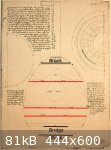
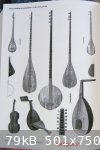


|
|
|
vinzenz
Oud Admirer

Posts: 5
Registered: 12-22-2010
Member Is Offline
|
|
hello jdowning,
thank you very much for your detailed work. i have read it with much interest, because one of my favorite books is " historical lute construction"
from robert lundberg.
vinzenz
Vinzenz Bachmayer
Luthier
Unterer Anger 16
80331 München
Germany
|
|
|
jdowning
Oud Junkie
    
Posts: 3485
Registered: 8-2-2006
Location: Ontario, Canada
Member Is Offline
Mood: No Mood
|
|
Thanks for your interest Vinzenz.
Lindberg's book is the best that there is on the subject and is useful to both oud and lute makers. There is little difference between making an oud
and making a lute. If you can make an oud you can make a lute - and vice versa.
This current work on comparing historical oud and lute geometry - part of which is currently posted on this thread for information - is to be subject
of a formal presentation in London, England towards the end of next year. Hopefully, by then, sufficient data will have been accumulated to allow at
least some tentative conclusions to be drawn!
The text of the London presentation will then be published 'on line' for free download.
|
|
|
jdowning
Oud Junkie
    
Posts: 3485
Registered: 8-2-2006
Location: Ontario, Canada
Member Is Offline
Mood: No Mood
|
|
The Brussels M.I.M. oud #0164 is an interesting instrument.
It bears a very close resemblance to the engraving of an oud in Napoleon's "Description de l'Egypt" in all major respects. Could it even have been the
actual model used by the French engraver at the end of the 18th C - given that the engraving contains some practical simplifications such as single
rather than double courses (both instruments have 7 double courses)?
The low resolution images provided for this analysis - courtesy of the Brussels Musical Instrument Museum - nevertheless make the similarities clear
enough. Here we see an oud with a straight sided peg box, neck joint cut on a slant with no 'bracelet', a bowl that is not semi circular in section, a
'cut in' rosette, closely spaced small rosettes that make the fitting of a brace (4 mm wide) immediately below the large rosette impossible (it must
be located below the small rosettes instead), a large pick guard that extends from bridge to the small rosettes and a 'mustache' style bridge. Note
also that the design of the small rosettes is a six point star motif in both cases.
Although the resolution of the images is not sufficient to be absolutely certain, the peg heads seem to be almost identical in design.
The half sound board overlay demonstrates that the deep bowl section is not semicircular. Modern lute makers once assumed that lute bowls should be
made perfectly semicircular in section but few, if any, surviving lutes, in fact, have semi circular section bowls. The same may apply to historical
ouds.
The absence (or otherwise) of a brace just below the rosette needs to be verified by examination of the original oud. There is no obvious sign of a
brace in the rosette images.
Next to look at the geometry in detail.
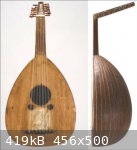

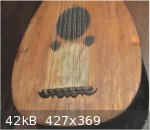
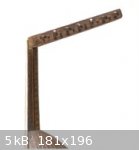
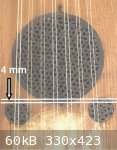
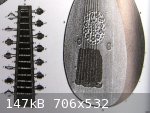
|
|
|
bulerias1981
Oud Junkie
    
Posts: 763
Registered: 4-26-2009
Location: Beacon, NY
Member Is Offline
Mood: John Vergara Luthier Lord of the Strings instrument making and repair
|
|
Yes, these two examples are looking very similar. Esepially when it comes to the soundhole/plectrum guard/lute-like pegbox scheme.
|
|
|
jdowning
Oud Junkie
    
Posts: 3485
Registered: 8-2-2006
Location: Ontario, Canada
Member Is Offline
Mood: No Mood
|
|
The Brussels #0164 oud is an example of Type 1 geometry - the profile of the upper half of the sound board being described by an arc of radius equal
to the maximum width of the sound board.
The geometry of the oud is somewhat similar in many respects to that of the Type 1 Christoffolo Hoch lute previously posted which incorporates an
ancient geometrical shape of sacred significance in many cultures - the so called 'Vesica Piscis ("fish bladder").
A Vesica Piscis is created when two circles of equal diameter intersect - the centre of one of the circles being located anywhere on the circumference
of the other. This produces an 'eye' or almond shape (also known known as 'mandorla' in Italian = almond nut ). The attached image shows the
construction of a Vesica Piscis.
It can be readily proven that if the minor axis of the Vesica Piscis is one unit then the length of its major axis is the square root of 3 = 1.7320508
.......
The sound board profile of the Brussels oud is part of a Vesica Piscis (V.P.). If a smaller V.P. is created inside this profile with its minor axis of
length equal to 2 units (or half the maximum width of the sound board) then the top of the V.P. (point B) is locates the top of the sound hole and the
bottom of the V.P. is the location of the bottom of the sound board. The front edge of the bridge is located at 1 unit from the bottom of the sound
board or 0.7320508 Unit from E, centre of the widest part of the sound board.
It is not possible to be absolutely precise when working with this low resolution image of the oud (and there is also some of the inevitable asymmetry
of the original instrument to take into account). However, this is my preferred solution (A) in the absence of a higher resolution image being
available. A very close alternative solution (B) for locating the front edge of the bridge is to use a 3:4:5 triangle (as proposed on some of the
geometries previously posted). This gives a slightly greater distance from the bridge to point E of 3/4 Unit or 0.750 Unit (about 2.5% difference).
The proposed geometry is as follows:
The maximum width of the sound board is 4 units and the half profile of the upper sound board is described by an arc of radius R1 (4 units) with
centre at X. Drawing a Vesica Piscis
2 units wide with centre at E defines the top of the sound hole, the bottom of the sound board and the front edge of the bridge. The curve of the
bottom of the sound board (point G) is described by an arc of radius R2 with centre at A.
Dividing the distance from E to the top of the sound hole B into 3 equal parts gives the bottom of the sound hole at 1 part from E and the sound hole
centre at 2 parts from E. The profile of the lower part of the sound board is described by an arc of radius R3 equal to the distance EC - its center
quickly found by trial and error, using dividers, to blend in with arcs R1 and R2.
The diameter of the rosette (not the sound hole - an important detail) is 1/3 the width of the sound board measured at the centre of the sound hole.
All a bit complicated to put into words but the attached diagram of the geometry should make it clear.
The geometry of the sound hole/rosette will be examined next.
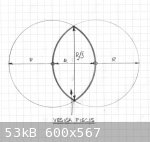
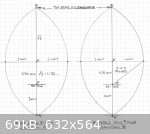
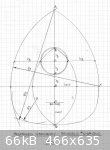
|
|
|
jdowning
Oud Junkie
    
Posts: 3485
Registered: 8-2-2006
Location: Ontario, Canada
Member Is Offline
Mood: No Mood
|
|
The rosette of the Brussels #0164 oud is cut directly into the sound board like a lute rosette - unlike a modern oud where the rosette (Shamsa) is
separate and glued behind a circular sound hole.
The sound hole in a lute rosette is the diameter of the open area of the rosette pattern that may be less than the overall diameter of the rosette.
This is the case with the Brussels #0164 oud - the whole area of the rosette being stained a dark colour.
With the usual caution about working with reduced scale, relatively low resolution images, the overall diameter of the rosette is 1/3 the width of the
sound board measured at the centre of the rosette. The sound hole diameter, however, is equal to the distance EC (see Proposed Geometry image
previously posted) - less than 1/3 sound board width.
(Interestingly, Arnault de Zwolle states that the sound hole diameter of his lute is 1/3 the width of the soundboard yet his geometrical construction
results in a sound hole that is of smaller diameter than this).
The geometrical relationship of the large and small sound holes appears to be that the diameter of the open area of each small sound hole is 1/4 the
diameter of the large sound hole. The centres of the small sound holes are spaced equal to the large sound hole diameter with the distance from the
main sound hole centre being determined by a 3:4:5 right triangle construction.
The complicated looking rosette pattern is very simply constructed using a pair of dividers set to a fixed radius of 1/6 sound hole diameter.
Step 1 is to describe a circle for the centre of the rosette. The dividers are then used (at the same radius setting) to divide the circle into 6
equal parts. The 6 intersection points on the circumference then form the centres for another series of circles (of the same radius) - see Step 2 -
and so on to complete the pattern.
This construction results in a complex of intertwined Vesica Piscis figures - confirming, perhaps, the overall theme of the oud geometry?
A series of supplementary half radius circles is used to create small 'cross links' in the pattern - best made clear by the attached sketch of the
rosette pattern.
The six point geometry of the main rosette is reflected in the six point pattern of the small rosettes.
So, if the geometry proposed here is valid, then this rather roughly made example of an oud may represent a simple yet sophisticated design - based
upon ancient geometry - requiring only a pair of dividers and a straight edge ruler to construct.

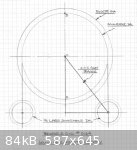
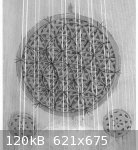
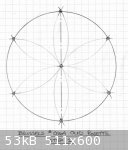
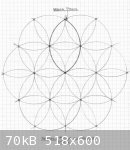
|
|
|
bulerias1981
Oud Junkie
    
Posts: 763
Registered: 4-26-2009
Location: Beacon, NY
Member Is Offline
Mood: John Vergara Luthier Lord of the Strings instrument making and repair
|
|
Quote: Originally posted by jdowning  |
The attached rough sketch of a Nahat bridge cross section compared to a more 'conventional' traditional oud bridge is intended to clarify the
dimensional difference between the front edge of the bridge and front edge of the bridge tie block. It would seem that the Nahat design imposes a
greater rotational torsion on the sound board - string tension being equal.
|
Nazih Ghadban still builds a lot of his bridges in this fashion.
|
|
|
jdowning
Oud Junkie
    
Posts: 3485
Registered: 8-2-2006
Location: Ontario, Canada
Member Is Offline
Mood: No Mood
|
|
Brussels oud #0404 is quite different in geometry from oud #0164 yet both are designated as 'Egyptian' by the Brussels Musical Instrument Museum.
Neither Type 1 nor Type 2 geometries generate the required narrower elongated profile or the relatively smaller sound hole diameter.
Like oud #0164 the bowl is not semi circular in section but is considerably deeper - particularly around the widest part of the sound board.
This profile is reminiscent of the oud arbi once common in Morocco and Tunisia. The oud arbi has a number of lute like features - relatively long
neck, fretted and with cut in rosettes. It has four courses and speculation has it that it may represent a design of oud that originated in Moorish
'Spain' - at a time when ouds were fretted and carried four courses.
The attached image is of a Tunisian Sheik with an oud arbi. As far as can be determined from this photograph the profile of this instrument and the
Brussels #0404 oud are practically identical.
In order to generate the profile of the upper part of the sound board the maximum width of the sound board is divided into four equal parts or units.
The upper sound board profile is an arc described by R1 (6 units in length) with its centre at Z - 4 units from the sound board centre line. The lower
sound board profile is semi circular described by R2 (2 units long or half the sound board maximum width).
The centre of the sound hole C is located at the intersection of arcs described by R3 (2 units in length - i.e. half a vesica piscis).
The diameter of the sound hole is 1 unit or 1/4 maximum sound board width.
The front edge of the bridge is located by means of a 3:4:5 right triangle - dimension '4' being 1 unit in length (so it follows that dimension '3' is
3/4 unit).
So far 3 distinct geometrical profiles have been established - designated in this thread as Type 1, Type 2 and Type 3 that define upper sound board
profiles. Lets take this a step further.
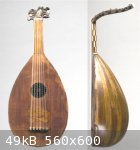

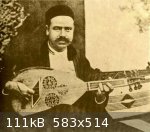
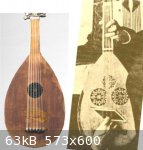
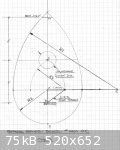
|
|
|
jdowning
Oud Junkie
    
Posts: 3485
Registered: 8-2-2006
Location: Ontario, Canada
Member Is Offline
Mood: No Mood
|
|
The basic assumption throughout this investigation is that the ancient luthiers generated their oud and lute geometries not by application of complex
mathematics but simply - employing only a pair of dividers and a straight edge and using whole numbers 1,2,3,4,5 ... etc. or fractions comprised of
whole numbers (harmonic proportions).
This assumption has been verified so far in the Type 1, 2 and 3 geometrical constructions that define the upper sound board profiles. (The lower sound
board profiles on the other hand can vary from a simple semi circle to a more complicated 'flattened' shape generated by blending arcs of different
radii).
Logically, the upper sound board profiles can be increased in relative length by increasing R1 by one unit at a time to produce Type 4, Type 5 ... and
so on.
The attached image is a sketch showing the variation of profile with R1 increasing in length in steps of 1 unit. The lower sound board profile is
drawn as a semi circle for simplicity.
In order to examine this possibility further let's next look at some examples of surviving lutes.
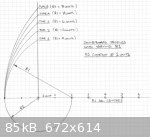
|
|
|
jdowning
Oud Junkie
    
Posts: 3485
Registered: 8-2-2006
Location: Ontario, Canada
Member Is Offline
Mood: No Mood
|
|
The 14th C Persian Kanz al-Tuhaf manuscript gives the overall dimensions of an oud that do not make much sense in that they describe an instrument
that is proportionally very long yet pencil thin. This apparent anomaly has been attributed to scribal error in recording the ancient measurements. In
article #32 in the Galpin Society Journal, May 1979, Curtis Bouterse proposes corrected dimensions that produce a more reasonable looking oud.
The attached geometry has been drawn according to the dimensions proposed by Bouterse (and assuming a finger unit is equal to 2.25 cm as given by
Farmer).
Bouterse does not propose a profile of the upper part of the sound board (the lower part is assumed to be a semi circle).
However, assuming that the width of the neck joint is about
45 mm (2 finger units) for a 5 course oud and that the upper sound board profile is a simple circular arc described by radius R then - if the sound
board is 4 basic units wide (or 15 finger units) - an R equal to 8.53 units connects the widest part of the sound board to the neck joint very
closely.
Note also that if the neck length is extended to accommodate 7 frets (as it would be for a European lute of the late 15th/early 16th C) R becomes
equal to 8 basic units making this a Type 5 geometry.
A crude drawing of an oud in the Kanz al-Tuhaf confirms this elongated almond shape - one that clearly represents a distinct transition at the neck
joint unlike many early representations of early ouds (and mediaeval lutes) in the iconography where there is a smooth transition from the bowl
profile to the neck.
The attached images of early Sassanid (Persian) metalwork 6th/7th C show the early style of oud without neck joint.
For comparison the oud represented on a 12th C. ivory box from the Iberian Peninsula ('Spain') shows a five course oud with the same early general
profile with no neck joint (? but hard to say for sure). Note the 'mustache' style bridge located close to the widest part of the belly and semi
circular profile of the lower part of the sound board.
The string length of the Kanz al-Tuhaf oud - deduced from the measurements given in the manuscript (again using Farmer's value for a finger unit of
2.25 cm) - is 67.5 cm.
(Post revised and updated 22 March 2011)

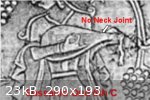
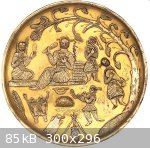

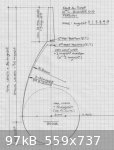
|
|
|
jdowning
Oud Junkie
    
Posts: 3485
Registered: 8-2-2006
Location: Ontario, Canada
Member Is Offline
Mood: No Mood
|
|
There are no surviving lutes with the proportions given in the 14th C Kanz al-Tuhaf (i.e. with R = 8.53 units and neck length = 1/4 total length).
So let's now look for some surviving lutes from the early 16th C with a Type 5 geometry.
(Post revised and updated 22 March 2011)
|
|
|
jdowning
Oud Junkie
    
Posts: 3485
Registered: 8-2-2006
Location: Ontario, Canada
Member Is Offline
Mood: No Mood
|
|
The renowned German luthier Laux Maler was active in Bologna, Italy during the first half of the 16th C. There are only 5 surviving examples of his
instruments - non complete only fragments and altered originals. They all have an elongated almond shaped profile. Surviving lutes by Maler's
contemporary Hans Frei also have identical profiles.
The attached image is an example of a lute bowl by Maler in the Victoria and Albert Museum in London. (Note that the 'neck' and 'sound board' have
been added for display purposes only and may not necessarily represent the original relative proportions of the lute neck, sound hole and bridge size
and placement).
Working from a full size drawing of an original Maler lute sound board (#M.1.54 in the Germanisches National Museum, Nurnberg, Germany) the attached
diagram gives a proposed geometry for the original instrument.
The construction is self explanatory. The maximum width of the sound board is 4 equal units and radius R1 of 2 units gives the position of the centre
of the sound hole and the bottom of the sound board. The sound hole diameter is 1 unit and the front edge of the bridge is placed at 1/4 YZ the
distance from the bottom edge of the sound hole to the bottom edge of the sound board Z. (Distance YZ = 3.5 units).
The profile of the upper part of the sound board is an arc described by R = 8 units (i.e. a Type 5 geometry). The profile of the lower part of the
sound board is a blended combination of arcs generated by R, R2 and R3 = 1.5 units.
The attached image is a reconstruction of the Maler lute that I made some years ago based upon the M.1.54 lute sound board geometry. This has been
made with a neck of sufficient length to accommodate 8 frets - as would have been commonly found in the second half of the 16th C. This results in a
string length of 73 cm. However, new evidence now suggests that the original lute may have had a shorter neck than this - sufficient for 7 frets - and
a string length of 67.5 cm.
(Post revised and updated 22 March 2011)


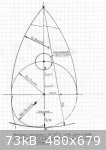
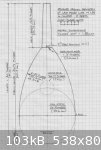
|
|
|
jdowning
Oud Junkie
    
Posts: 3485
Registered: 8-2-2006
Location: Ontario, Canada
Member Is Offline
Mood: No Mood
|
|
A preliminary examination of 2 full sized drawings of lute sound boards by Laux Maler (Prague National Museum # 65 4408E and # 6551931D both modified
from their original state) are both Type 5 geometry and similar to the construction previously posted for the #M.1.54 lute. Sound hole diameter,
however, is 1/3 the width of the belly measured through the centre of the sound hole.
Examination of full sized drawings of surviving lute sound boards by Hans Frei - Maler's contemporary in Bologna - #67/1965 in the Warwick County
Museum and another (unknown cat. number) in the Kunsthistorisches Museum, Vienna (both modified from their original state) again are
Type 5 geometry and closely follow the Maler design.
These four examples will be examined in more detail at a later date.
Maler lutes were later prized in both the 17th and 18th C fetching very high prices even in poor condition.
Thomas Mace writing in 1676 gives two examples of Maler lutes ("pitiful old battered and cracked things") costing 100 pounds sterling - an enormous
sum of money in those days.
Ernst Gottlieb Baron writing in 1727 mentions lutes by Maler and Frei that in his time still "commanded very high prices because they are rare and
have a magnificent tone" However this is not the whole story as to why these old lutes continued to be in demand 175 years after the death of their
makers. E.G. Baron inadvertently gives the reason in his observation that "it is remarkable that they (i.e. Maler and Frei) were working in today's
fashion" However, it is obvious that this style of lute attributed to Maler and Frei was in fact the style copied by the luthiers in the late 17th and
early 18th C. if original Maler and Frei lutes were not available for conversion into the 11 or 13 course lutes of the time.
If this is the case then the surviving lutes from that period will also be of Type 5 geometry like the Maler and Frei lutes of the early 16th C. More
on this later.
For information I attach an article written in the 1970s that shows how this type of 16th C lute was converted in later years to suite contemporary
music styles.
Note also that Maler and Frei made lutes of other geometry than Type 5 - but none have survived to this day.

Attachment: MF Lutes 2.pdf (594kB)
This file has been downloaded 574 times
|
|
|
jdowning
Oud Junkie
    
Posts: 3485
Registered: 8-2-2006
Location: Ontario, Canada
Member Is Offline
Mood: No Mood
|
|
So the early 16th C 'long string length' ouds of Maler and Frei survived because they were not only outstanding examples of fine luthier craftsmanship
but also were suitable for conversion into the 'long string length' (around 70 cm stopped string length) 11 and 13 course lutes of the second half of
the 17th C and first half of the 18th C.
Here are three representative examples from the iconography that illustrate fairly accurately some of the Type 5 geometry lutes popular in the late
17th C.
The first is an engraving from "Livre de Musique pour le Lut" made by the author Sr. Perrine in 1682 - an 11 course French lute.
The second is a painting "The Lute Player" by Flemish artist Hendrick Maertensz Sorgh in 1661 showing a lute with extended bass courses.
The third is the well known painting of French lutenist Charles Mouton by artist Francois de Troy, 1690, in Le Louvre, Paris. The lute depicted is an
11 course French lute.
It is interesting to observe that the rosette - given the low resolution of the image - seems to be of the distinct pattern found on surviving Laux
maler lute sound boards. The attached rosette pattern is copied from the converted Maler lute #65 1408E in the Prague National Museum.
Note the proportionally small diameter rosettes in all cases.
Another note for interest. The 'banding' around the edge of the sound board in each case is most likely a strip of parchment (thin leather membrane)
glued in place to reinforce and protect the edges against damage and wear. Thomas Mace calls this parchment strip a "lace" and describes, in detail,
the procedure for removing and replacing it when a sound board has to be removed for repairs (something that was regularly required in those
prevailing humid conditions in 17th C England).
It is also interesting to observe that this method of sound board edge reinforcement was also used on some ouds like the oud arbi (and my old
'Egyptian' oud) - although the leather strip usually only covered the lower half of the sound board edge.
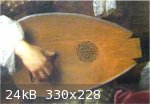
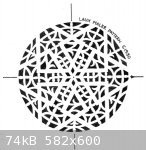
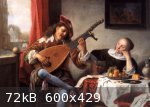
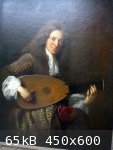

|
|
|
jdowning
Oud Junkie
    
Posts: 3485
Registered: 8-2-2006
Location: Ontario, Canada
Member Is Offline
Mood: No Mood
|
|
In this search to find examples of comparable geometry of old ouds and lutes, the maximum radius of the upper sound board profile found to date is in
the proposed geometry of an oud given by the 14th C Persian Kanz al-Tuhaf with an R value of 8.53 basic units (maximum sound board width being 4 basic
units).
In Europe, a small lute like instrument known as a mandola (larger) or mandolino (smaller) - popular in the 17th and 18th centuries - with gut double
courses was played 'finger style' like a lute. (Not to be confused with the later wire string Neapolitan Mandolin). Many of these instruments and
their patterns survive in original condition including some of those made by luthier Antonio Stradivari.
I have about 10 full size original Mandolino patterns - traced from the original instruments. The profiles of these instruments vary but include some
that are very slim and elongated.
The attached example is an ivory mandolino from the Charles van Raalte Collection, Dean Castle, Scotland that I had the opportunity to examine and
measure some years ago. The instrument has a string length of 33.6 - 33.7 cm.
The attached geometry of the full size tracing of the sound board profile shows an upper sound board profile described exactly by an arc of radius R1
equal to 14 basic units.
Radius R2 (2 basic units) defines the bottom of the sound board D and bottom of sound hole A.
The front edge of the bridge from the bottom of the sound board - distance BD - is 1/3 of the distance CD from the centre of the sound hole to the
bottom of the sound board. This relationship in turn defines the diameter of the sound hole.
The lower profile of the sound board is modified from a semicircle to a more 'flattened" shape by an arc of radius R3 equal to distance BD.
It is interesting to note that the R value for one of the surviving Stradivarius mandolino profiles is 16 basic units which may be the top limit for
lute upper sound board geometry.

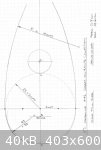
|
|
|
jdowning
Oud Junkie
    
Posts: 3485
Registered: 8-2-2006
Location: Ontario, Canada
Member Is Offline
Mood: No Mood
|
|
As this work is in progress and new information has come to light, it has been necessary to update and revise some of the previous postings. The
revised posts have been noted accordingly.
Note that more detailed information on the revised drawings (particularly relating to 'finger' units) can be found under the topic "Ancient Scales of
Measurement?" in the 'Advice, Tips and Questions' forum.
|
|
|
jdowning
Oud Junkie
    
Posts: 3485
Registered: 8-2-2006
Location: Ontario, Canada
Member Is Offline
Mood: No Mood
|
|
Apart from the 14th C Persian manuscript 'Kanz al-Tuhaf' that gives the dimensions of an oud there is the 14th C description of a 4 course oud by the
Arab writer Ibn al-Tahhan. This description - like that of the 'Kanz al-Tuhaf - is corrupted due to scribal error in recording of the dimensions. This
is discussed in more detail in the post "Ancient Scales of Measurement?" on the Forum.
The corrected dimensions and proposed geometry is shown in the attached image.
It can be seen that the profile of the upper sound board is identical to that of the surviving Maler lutes of the 16th C. The Maler lute geometry
previously posted differs in the neck length and the slightly lower bridge position this difference being half a finger unit - increasing string
length from 36 to 361/2 finger units. So, is it possible that Maler used the Ibn al-Tahhan oud geometry as a model for this style of lute?
Maler's lute would have required a slightly longer and wider neck - to accommodate 7 frets and six courses. He might have achieved this by lowering
the neck joint position by 1/2 a finger unit and then lowering the bridge position by the same amount to give a string length of 36.5 finger units. In
order to maintain structural integrity, the length of the neck block would have been maintained (i.e. by adding 1/2 finger unit of material on the
bridge side).
Dependent upon the metric value chosen for an ancient 'finger' unit, the string length of the Ibn al-Tahhan oud might have been 67.5 cm using a finger
unit equal to 1.875 cm (Stecchini's 'natural' unit).
The width of the surviving Maler M.I.54 sound board is 29.6 cm equivalent to 16 finger units equating to a finger unit equal to
1.85 cm (Stecchini's trimmed finger unit). This gives a proportional string length of 67.5 cm. Interesting!
The bridge position and sound hole diameter of the Maler sound board also agree closely when a trimmed finger unit is used
Ibn al-Tahhan provides no information about sound hole size and position but this, perhaps, might now be deduced from the relative proportions of the
Maler lute?

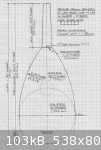
|
|
|
jdowning
Oud Junkie
    
Posts: 3485
Registered: 8-2-2006
Location: Ontario, Canada
Member Is Offline
Mood: No Mood
|
|
For completeness, the attached image shows the proportions of an oud described by the Ikhwan al-Safa (Brotherhood of Purity) in the 10th C. as well as
an image of a proposed development of the geometry that suggests a link to the 19th C ouds of Lebanon and Syria (for example the Type 2 ouds by the Al
Arja and Nahat families).
The details are discussed in the topic "Ancient Scales of Measurement?" on this Forum.
The Ikhwan al-Safa oud had four courses "no more no less" and was fretted.
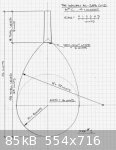
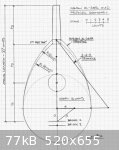
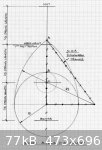
|
|
|
jdowning
Oud Junkie
    
Posts: 3485
Registered: 8-2-2006
Location: Ontario, Canada
Member Is Offline
Mood: No Mood
|
|
For information.
The proposed rosette pattern of the Brussels #0164 seven course oud, previously posted in this thread, is another very ancient geometrical
construction with sacred or mystic meaning in many societies - known today as the "Flower of Life".
One of the earliest representations of this pattern - carved in stone - can be found at the Temple of Osiris, Egypt - said to date to about 3000
BC.
The attached image shows one of a connected pair of "Flowers of Life" - identical to the Brussel's oud rosette pattern. Not to suggest that the oud is
that old, however!!
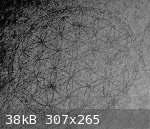
|
|
|
jdowning
Oud Junkie
    
Posts: 3485
Registered: 8-2-2006
Location: Ontario, Canada
Member Is Offline
Mood: No Mood
|
|
No lutes made prior to the 16th C survive today.
There is an interesting carving in the Lutheran cathedral, Ulm, Germany made in 1470 by Jorg Syrlin the Elder. It depicts 'Pythagoras' playing a six
course lute and seems to be rendered with some precision, accurately representing the proportions and geometry of the lute.
Placing the proposed developed geometry of the 10th C Ikhwan al-Safa oud, previously posted, as an overlay on an image of the lute demonstrates a
remarkable agreement between the oud and lute geometries. Both are Type 2 sound board profiles with a semi circular lower part.
The lute has six courses (compared to four on the oud) so the lute neck joint has been placed lower (towards the bridge) to make the fingerboard
wider. The lute fingerboard has also been extended at the nut end sufficient to increase the total fingerboard length to just accommodate 8 frets
(common during the 16th C).
From the oud geometry the string length is 27 units and sound board width is 16 units so if an average value of 2cm is taken for a 'finger width' the
string length becomes 54 cm and sound board width 32 cm. neck joint width is 4cm at this scale. Note also that the distance from the bridge to the
widest part of the sound board (X axis) is 3 'finger' units - exactly the distance (3 'asabi') given by Al Kindi writing in the 9th C.
For comparison see the proposed geometry of ALAMI's 19th C
Al Arja oud posted at the beginning of this thread. A more detailed analysis of the geometry of this oud has been published in FoMRHI Quarterly No
116, August 2010. Comm. 1911.
http://www.fomrhi.org
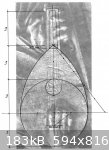

|
|
|
jdowning
Oud Junkie
    
Posts: 3485
Registered: 8-2-2006
Location: Ontario, Canada
Member Is Offline
Mood: No Mood
|
|
I note that FoMRHI Quarterly No 116 is currently not available for free download from the FoMRHI website (as are Nos 115 and earlier).
So here is a copy of the article Comm. 1911 for those interested.
Attachment: Pythagoras of Ulm FoMRHI.pdf (987kB)
This file has been downloaded 871 times
|
|
|
jdowning
Oud Junkie
    
Posts: 3485
Registered: 8-2-2006
Location: Ontario, Canada
Member Is Offline
Mood: No Mood
|
|
For information - I have just received the following information on the Brussels #0164 oud from the museum.
The rosettes are separate and 'set in' flush with the sound board surface.
Vibrating String Length - 637 mm
Sound board Width - 401 mm
Sound board Length - 516 mm
Neck Length - 224 mm
Top of Rosette to bottom of Sound board - 358 mm
Bridge to bottom of Sound board - 9.8 mm
The bowl has 25 ribs.
The measured dimensions are close enough (about 2% agreement) to support the proposed geometry.
|
|
|
jdowning
Oud Junkie
    
Posts: 3485
Registered: 8-2-2006
Location: Ontario, Canada
Member Is Offline
Mood: No Mood
|
|
I came across another image of the Brussels #0164 0ud today. Taken from another angle it confirms that the 7th course runs outside the fingerboard so
is only played 'open' and not 'stopped' on the fingerboard.
It also shows that the bridge is not drilled for the strings but is slotted in the way that early guitar and vihuela bridges were made during the 16th
and 17th C.
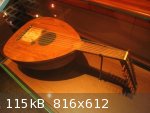
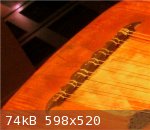
|
|
|
jdowning
Oud Junkie
    
Posts: 3485
Registered: 8-2-2006
Location: Ontario, Canada
Member Is Offline
Mood: No Mood
|
|
'Libro de los juegos' (Book of Games) by king Alphonso X of Castile (1221 -1284) contains this illumination of three ladies playing chess - one also
playing an oud (how does she do that?!).
Like the Brussels oud , the oud depicted has a straight sided peg box. Another connection with Moorish 'Spain' perhaps?

|
|
|
| Pages:
1
2
3
4
5 |